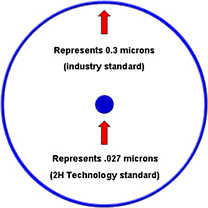
 |
||
| NanoMasks FAQS | Why we test to .027 Microns | |
| Glossary | ||
Filtration efficiency is the measurement of a filterís capacity to effectively remove particulates, such as virus and bacterium, from moisture or air over a specified period of time. It should be noted that the number of digits after the decimal point (i.e. .99 vs. .999) is a function of the test and not necessarily a reflection of filter performance. It should also be noted that it is common to challenge air filters at 0.3 microns during filtration efficiency testing on the premise that if water droplets, or other large particles, are removed from an air stream all pathogens are removed as well. While it is obviously much easier to achieve a favorable result at 0.3 microns; it has been proven that relative efficiencies will diminish as the contaminates decrease in size (virus are much smaller than bacterium), when filters are subjected to higher volumes of airflow or higher quantities of particulate, and when filters are in use over a prolonged period of time. Efficiency is more meaningful then when stated in terms of percentage of efficiency and particulate size. To put this into perspective, the image to the left shows the relative differential between 0.3 microns and 0.027 microns (the challenge particulates size for 2H Technology testing) and the following chart demonstrates why testing below 0.3 microns in size is relevant |
||
 |
||
| Species | Size in Microns | Associated Diseases |
| Bacteriophage ØX174 | 0.025 to 0.027 diameter | Test virus used by Nelson Laboratories to test 2H Technologyô filtration efficiencies |
| Hepatitis Virus (HBV) | 0.042 to 0.047 diameter | Hepatitis B |
| Adenovirus | 0.07 to 0.09 diameter | Respiratory Infections |
| HIV | 0.08 to 0.11 diameter | Acquired Immunodeficiency Syndrome |
| Filoviruses | 0.08 diameter 0.79 to 0.97 length |
Ebola Virus |
| Bunyaviridae | 0.08 to 0.12 diameter | Hanta Virus |
| Orthomyxoviridae | 0.08 to 0.12 diameter | Influenza A, B, and C |
Coronaviridae (SARS-CoV) |
0.10 to 0.12 diameter | SARS |
Varicella-Zoster Virus |
0.11 to 0.12 diameter | Herpes |
| Cytomegalovirus | 0.12 to 0.20 diameter | Pneumonia, Hepatitis, Retinitis, Encephalitis |
| Variola Virus | 0.14 to 0.26 diameter
0.22 to 0.45 length |
Small Pox |
| Serratia Marcescens | 0.45 diameter | Extraintestinal Infections, |
| Pseudomonas Aeruginosa | 0.50 to 1.0 diameter 1.5 to 4.0 length |
Endocarditis, Pneumonia, Osteomyelitis, Nosocomial Infections, Meningitis, Septicemia |
| Staphylococcus Aureus | 1.0 diameter | Pneumonia, Osteomyelitis, |
| Mycobacteriumtuberculosis | 1.0 to 5.0 diameter | Tuberculosis |
| Bacillus Anthracis | 1.0 to 1.5 diameter 3.0 to 5.0 length |
Anthrax Infection |